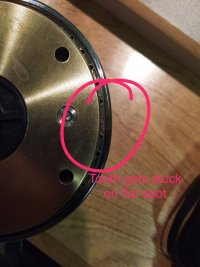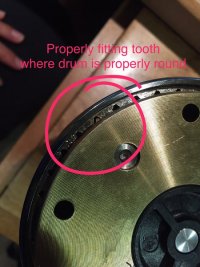So, I'm looking to upgrade my E-23 Mk II Barlow 15 winches to something self-tailing. Right now I've got 1 Lewmar 16 CST. I want a matching one, but don't want to pay full price for a new one. I have an option to get another one at a very good price that is in perfect condition in every way but the one that's probably most important--the base of the winch drum itself isn't perfectly round. It may have been dropped or something at some point. There are two slightly flat spots--one on either side of the winch base--that occasionally catch on the gear when the winch is turning.
I think I know the answer, but is it possible to "spread" the winch drum at those spots to make it round enough to function without a problem? If so, how would one do this? Anyone ever done it before?
I will note that when I contacted Lewmar about this, they said "get a replacement drum." That doesn't surprise me, but the replacement drum would be more than what I'd pay for the currently damaged winch, and together, would be as much as a brand new one.
Side question--anyone also installed winch pads to get the right angle of attack for their jib sheets? I measured and the Barlow 15s mounted right on the coaming seem to be quite a bit lower than the recommended angle (the Lewmar 16s should be at 5-8 degrees). Also, is it good, bad, or does it matter at all that the winches are angled out away from the center of the boat? I've tried to find anything about vertical angles in winch placement and haven't found anything.
Second side question--thoughts on putting the Barlow 15s further back as a second set of winches for a genny? I've heard of others doing this but not sure if it's overkill for this boat.
I think I know the answer, but is it possible to "spread" the winch drum at those spots to make it round enough to function without a problem? If so, how would one do this? Anyone ever done it before?
I will note that when I contacted Lewmar about this, they said "get a replacement drum." That doesn't surprise me, but the replacement drum would be more than what I'd pay for the currently damaged winch, and together, would be as much as a brand new one.
Side question--anyone also installed winch pads to get the right angle of attack for their jib sheets? I measured and the Barlow 15s mounted right on the coaming seem to be quite a bit lower than the recommended angle (the Lewmar 16s should be at 5-8 degrees). Also, is it good, bad, or does it matter at all that the winches are angled out away from the center of the boat? I've tried to find anything about vertical angles in winch placement and haven't found anything.
Second side question--thoughts on putting the Barlow 15s further back as a second set of winches for a genny? I've heard of others doing this but not sure if it's overkill for this boat.




